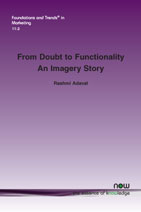From Doubt to Functionality: An Imagery Story
By Rashmi Adaval, Department of Marketing, University of Cincinnati, USA, rashmi.adaval@uc.edu
Abstract
Mental imagery and mental simulations play an important role in any consumption experience. For decades, however, the famed "imagery debate" dominated discussions on imagery and to some extent stymied research on how imagery impacts consumption. As researchers debated whether a picture-like component was part of the underlying mental representation or not, a researcher's inability to produce concrete evidence that people had indeed formed mental images was often used to challenge imagery-based explanations. Despite this, the last decade has witnessed burgeoning research on how consumers use imagery in a myriad of ways — often in the service of some larger goal. The monograph views imagery through this functional lens and reviews and organizes these findings.
This review provides a historical perspective on imagery research and then uses evidence from past research to lay down a conceptual foundation for new work that will undoubtedly emerge in the coming decades. Questions such as "What triggers imagery?" "Are there differences between perception and imagery?" "How do we use imagery to create simulations and imagine what we do not see?" "How does imagery exert an influence?" and "Are there individual and cultural differences in the ability to image?" are addressed. Then, to unify the somewhat diverse findings from imagery research conducted on consumers, the monograph organizes the research using two dimensions: The extent to which imagery is spontaneous or deliberate and whether it has cognitive or motivational antecedents. This framework is used to not only discuss the existing research but also to pose questions that remain to be answered.
From Doubt to Functionality: An Imagery Story
From Doubt to Functionality: An Imagery Story provides a systematic approach to address the role imagery plays in guiding consumer behavior. First, it makes sense to consider the conditions that elicit imagery, then to examine how people use it, and finally to explore avenues whereby this use of imagery can help to understand a host of consumption related phenomena. The objective of this monograph is to provide an integrative framework for looking at conditions that elicit imagery and its many effects.
